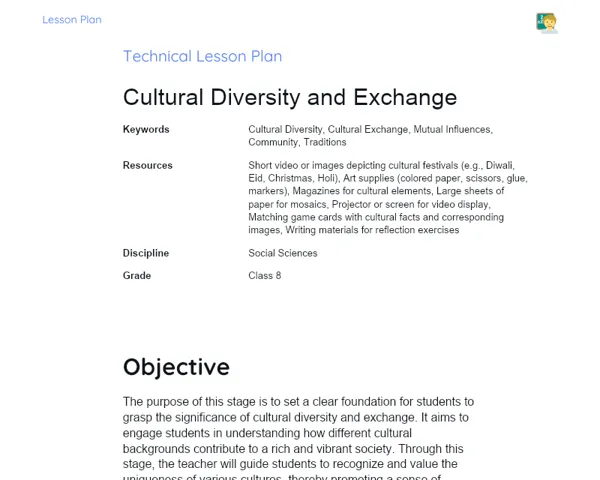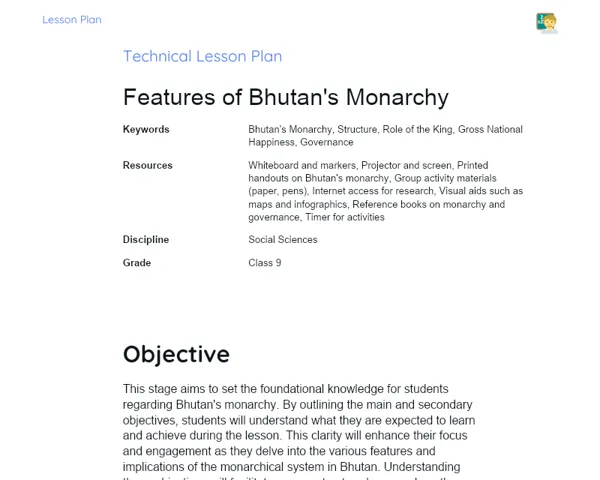Lesson Plan | Active Methodology | Historical Development of Ancient India
| Keywords | Ancient India, Social Structures, Economic Life, Family Roles, Trade, Craftsmanship, Role Play, Interactive Learning, Critical Thinking, Cultural Heritage |
| Necessary Materials | Paper and coloured markers for stalls and signage, Clay and other recyclable materials for crafting activities, Props for role-playing (e.g., hats, cloth items to represent goods), Play money or tokens for trading activities, Space for group presentations, Reference materials or illustrated guides on ancient Indian society, Costumes or traditional attire (optional) to enhance role-playing experience |
Premises: This Active Lesson Plan assumes: a 100-minute class duration, prior student study both with the Book and the beginning of Project development, and that only one activity (among the three suggested) will be chosen to be carried out during the class, as each activity is designed to take up a large part of the available time.
Objectives
Duration: (10 - 15 minutes)
This stage of the lesson plan aims to establish clear objectives that guide the learning experience related to the historical development of ancient India. By defining these objectives, students can focus on understanding the key social and economic structures that shaped daily life in ancient times. This clarity helps them connect their pre-studied knowledge with practical applications and discussions during classroom activities.
Main Objectives:
1. Develop an understanding of the social structures in ancient India, including family roles and community interactions.
2. Explore the economic life of ancient India, focusing on trade, agriculture, and craftsmanship.
Side Objectives:
- Encourage curiosity about historical figures and events from ancient India.
- Foster critical thinking about the impact of ancient Indian civilization on modern society.
Introduction
Duration: (10 - 15 minutes)
This stage of the lesson plan aims to engage students in thinking critically about their prior knowledge while connecting it to practical, real-life scenarios. The problem situations encourage them to reflect on the roles and responsibilities of individuals in ancient India, while the contextualization emphasizes the relevance of these historical elements to modern society. This approach fosters curiosity and lays the groundwork for deeper discussions during the lesson.
Problem-Based Situation
1. Imagine you are an ancient merchant trying to sell your goods in a bustling marketplace. What challenges do you think you would face in terms of trade and interactions with customers?
2. Think about the family roles in ancient India. How do you think children contributed to their families' daily activities? What responsibilities do you think they had?
Contextualization
Ancient India is a treasure trove of stories and knowledge that shapes our present. For instance, the unique crafts from ancient India, like intricate pottery and beautiful textiles, are still appreciated today. Students can relate to the idea of trade, just like when they visit local markets. They can also marvel at the influence of ancient kings on modern governance, sparking curiosity about who their favourite historical characters might be.
Development
Duration: (70 - 80 minutes)
This stage of the lesson plan encourages students to actively engage with the historical context of ancient India through collaborative and experiential activities. By working in groups to solve real-world problems or scenarios from ancient times, students enhance their understanding of social and economic structures. The activities are designed to be playful and relatable, fostering communication, creativity, and critical thinking, while allowing students to connect past experiences with contemporary relevance.
Activity Suggestions
It is recommended that only one of the suggested activities be carried out
Activity 1 - Trade Tales in the Bazaar
> Duration: (60 - 70 minutes)
- Objective: To understand the economic dynamics of ancient trade and the importance of negotiation and customer service.
- Description: In this activity, students will immerse themselves in the bustling world of an ancient Indian marketplace. They will role-play as merchants and customers, dealing with the challenges and delights of trade. Each group will be assigned a different type of goods (e.g., spices, textiles, pottery) and will create a small stall that represents their goods. The students will have to negotiate prices, understand the importance of quality, and the role of bartering in ancient trade.
- Instructions:
-
Divide the class into groups of up to 5 students.
-
Assign each group a specific product to trade, giving them time to design their stall and prepare their goods.
-
Students should come up with creative product names and pricing for their goods.
-
After setting up, groups will take turns being the merchants while others play customers.
-
Merchants will need to negotiate deals with customers while ensuring their goods are appealing.
-
Conclude with each group reflecting on what challenges they faced during the trade.
Activity 2 - Family Roles: A Day in the Life!
> Duration: (60 - 70 minutes)
- Objective: To comprehend the social structures and responsibilities within a traditional Indian family setting.
- Description: Students will explore the different roles within an ancient Indian family by creating a skit that portrays a day in the life of an ancient family. Each group will choose family members (like parents, children, artisans) and depict typical daily activities, emphasizing the significance of each role in contributing to family and community.
- Instructions:
-
Divide the class into groups of up to 5 students.
-
Each group will brainstorm and decide on the family roles they wish to portray.
-
Create a short skit that illustrates a day in the life of that family, including their jobs, responsibilities, and interactions.
-
Present the skits to the class while ensuring everyone participates.
-
After the presentations, hold a discussion reflecting on what they learned about the importance of family roles.
Activity 3 - Crafting History: Ancient Artisans
> Duration: (60 - 70 minutes)
- Objective: To appreciate the artistic skills and craftsmanship of ancient India while engaging in a creative hands-on project.
- Description: In this hands-on activity, students will learn about the craftsmanship of ancient India by creating their own simple crafts using recyclable materials. They will explore the significance of craftsmanship in ancient times while working together to design and produce a craft piece that reflects ancient styles.
- Instructions:
-
Gather students into groups of up to 5.
-
Provide materials like paper, clay, and other recyclables for students to use in their craft.
-
Each group must decide on a craft that represents a traditional ancient Indian craft (like pottery or weaving).
-
Students will create their crafts while discussing the historical significance and the skills artisans needed.
-
At the end of the class, students will present their crafted items to the class, explaining their processes and the history behind the craft.
Feedback
Duration: (15 - 20 minutes)
The purpose of this feedback stage is to consolidate the learning experience by encouraging students to share their insights and reflections from the activities. This collaborative discussion allows students to articulate their understanding of the social and economic structures of ancient India, reinforcing their knowledge through peer interaction. It also fosters a community of learners, where they can appreciate diverse perspectives and deepen their critical thinking about the content learned.
Group Discussion
Now that everyone has shared their experiences and insights from the activities, let's come together as a class to reflect on what we learned. Each group will take a moment to share one important thing they discovered about ancient India, whether it was about family roles, trade, or craftsmanship. This will help us see how everything connects and understand our past better. Who would like to start?
Key Questions
1. What was the most surprising thing you learned about the roles within ancient Indian families?
2. How did trading in the ancient marketplace differ from what you see in our local markets today?
3. Can you name a craft that you think is important in understanding the culture of ancient India, and why?
Conclusion
Duration: (10 - 15 minutes)
The purpose of this conclusion stage is to encapsulate the students' learning experiences, reinforcing the key concepts discussed throughout the lesson. By summarizing the main contents, connecting theory with practical applications, and highlighting the importance of ancient Indian history in everyday life, students can internalize their knowledge and foster a deeper appreciation for their cultural heritage.
Summary
In today's lesson, students explored the rich tapestry of ancient Indian society by delving into the social structures, economic activities, and craftsmanship that defined daily life. They actively participated in role-playing as merchants and customers in a bustling ancient marketplace, performed skits to showcase family roles, and engaged in hands-on craft-making activities that highlighted traditional skills. Through these experiences, they developed a comprehensive understanding of how the past influences the present.
Theory Connection
This lesson effectively bridged theory and practice by allowing students to not only learn about the historical development of ancient India but also to apply their insights in engaging activities. By acting out scenarios and creating artifacts, students connected theoretical knowledge with real-life applications, demonstrating how the social and economic practices of ancient civilizations are still relevant today in shaping our communities and cultural identity.
Closing
The exploration of ancient India's social and economic structures helps students appreciate their own history and recognize the continuity of culture. Understanding these fundamentals fosters a sense of identity and respect for the contributions of those before us. The lessons learned today about trade, family roles, and craftsmanship are not just historical facts; they are vital elements that have contributed to the diverse fabric of modern society, reminding us that our actions today are rooted in the legacies of the past.



